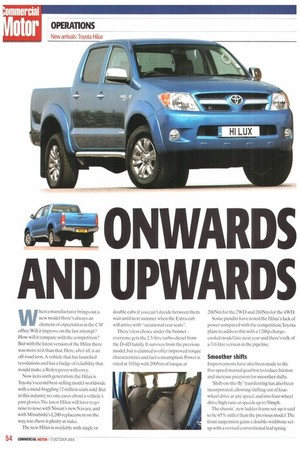ONWARDS AND UPWARDS
Page 56

Page 57

If you've noticed an error in this article please click here to report it so we can fix it.
When a manufacturer brings out a new model there's always an element of expectation in the CM office, Will it improve on the last attempt? How will it compare with the competition? But with the latest version of the Hilux there was more to it than that. Here, after all, is an off-road icon. A vehicle that has launched revolutions and has a badge of reliability that would make a Rolex green with envy.
Now in its sixth generation,the Hilux is Toyota's second best-selling model worldwide with a mind-boggling 12 million units sold. But in this industry no-one cares about a vehicle's past glories.The latest Hilux will have to go nose to nose with Nissan's new Navara, and with Mitsubishi's L200 replacement on the way, too, there is plenty at stake.
The new Hilux is available with single or double cabs; if you can't decide between them wait until next summer when the Extra-cab will arrive with "occasional rear seats".
There's less choice under the bonnet — everyone gets the 2.5-litre turbo-diesel from the D-4D family. It survives from the previous model, but is claimed to offer improved torque characteristics and fuel consumption. Power is rated at 101hp with 200Nm of torque at 200Nm for the 2WD and 260Nm for the 4WD.
Some pundits have noted the Hilux's lack of power compared with the competition:Toyota plans to address this with a 128hp chargecooled model late next year and there's talk of a 3.0-litre version in the pipeline.
Smoother shifts
Improvements have also been made to the five-speed manual gearbox to reduce friction and increase precision for smoother shifts.
`Shift-on-the-fly' transferring has also been incorporated, allowi ng shifting out of fourwheel drive at any speed, and into four-wheel drive/high ratio at speeds up to 50mph.
The chassis', new ladder-frame set-up is said to be 45% stiffer than the previous model.The front suspension gains a double-wishbone setup with a revised conventional leaf spring configuration at the rear to reduce unsprung weight.These mods are said to contribute to a 6% reduction in cab noise.
From a styling perspective the Hilux is an attractive vehicle for a pickup. Noticeably larger than the previous model, its front end has been smoothed over while the cabin is less box-like in appearance.The rear end still points upwards when unladen thanks to the degree of suspension travel, but this does not deter from its overall stance.
Cab enhancements include a car-like dashboard, improved storage and the dashmounted handbrake which has been relocated between the front seats. Interior space has increased noticeably, especially in the rear where the backrests now slope, which should improve passenger comfort on long journeys.
After several miles of mixed going during the press launch in the mountains of Southern Spain what struck us most was the Hilux's overall refinement. We'd had the previous model at CM as a long-term test vehicle so it was easy to appreciate the work that had been done to improve the new one.
The engine behaved impeccably, and though power was not outrageous the torque delivery was spread over a wide enough band to allow lazy gear changing. The shift itself was also an improvement, sliding smoothly from gate to gate, though the inherent looseness associated with pickups was still evident.
Degree of bounce
lhe chassis improvements were evident through the corners where body roll — for a pickup— was minimal and the steering with its best-in-class turning circle was solid yet communicative.The re was a degree of bounce from the rear suspension, but Toyota's chief engineer on the project says it's the price paid for solid off-road characteristics.
Switching to four-wheel drive Hilux proved surefooted and capable on the rough. Gripping and turning incisively into uneven corners and across severely undulated surfaces was all ma day's work. while the occupants felt comfortably cocooned from the action. Suspension control was nicely controlled, allowing the Toyota to put its power down without fuss.
The UK pickup market accounts for a third of Toyota's European sales. And the company knows that things are not going to be easy.
Maybe that accounts for the aggressive pricing—the single-cab 4x2 model costs £11,495, rising to £16,595 for the double-cab Invincible 4x4. Considering its capability we reckon that makes it a bit of a bargain.












































































































































































































